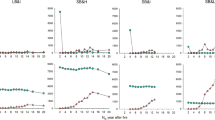Abstract
Modes of recruitment of each regenerated species after fire were investigated quantitatively in a Pinus densiflora forest in central Japan. There was a continuum of regeneration modes from species with abundant seedling populations (more than one individual m−2) to sprouters. The former included Erigeron canadensis, Eupatorium chinense var. simplicifolium, Rubus crataegifolius, Lespedeza bicolor forma acutifolia, Mallotus japonicus, Rhus javanica, Eurya japonica, Aralia elata and Weigela decora, whose seedlings accounted for 70% of total recruitment on the forest floor. Sprouts from stem bases which comprised much of the canopy prior to fire (e.g. Quercus serrata, Castanea crenata, Fraxinus sieboldiana and Prunus spp.), were vigorous and grew rapidly. Plants on both ends of the continuum dominated post-fire vegetation in the study sites.
Similar content being viewed by others
References
Auld, T. D. 1990. The survival of juvenile plants of the resprouting shrub Angophora hispida (Myrtaceae) after a simulated lowintensity fire. Aust. J. Bot. 38: 255–260.
Burrows, C. J. 1990. Processes of vegetation change. Unwin Hyman, London, UK.
Frost, P. G. 1984. The responses and survival of organisms in fireprone environments. In: Booysen, P. de V. & Tainton, N. M. (eds) Ecological Effects of Fire in South African Ecosystems. Springer-Verlag, Berlin, Germany.
Gill, A. M. 1975. Fire and the Australian flora: a review. Aust. For. 38: 4–25.
Goto, Y., Magarisawa, O. & Morisawa, T. 1989. Regeneration of vegetation following forest fire in northern Kanto, Japan. J. Jpn. Soc. Reveget. Tech. 15: 8–12 (In Japanese with English summary).
Goto, Y., Magarisawa, O. & Morisawa, T. 1992. Early stages of regeneration after fire in a Sugi (Cryptomeria japonica D. Don) forest in Kiryu City, Gunma Prefecture. Jpn. J. For. Environ. 34: 73–79 (In Japanese with English summary).
Heinselman, M. 1978. Fire in wilderness ecosystems. In: Hendee, J., Stankey, G. & Lucas, R. (eds.) Wilderness Management. USDA Forest Service, Miscell. Publ. No. 1365.
Keeley, J. 1987. Role of fire in seed germination of woody taxa in California chaparral. Ecology 68: 434–443.
Keeley, J. 1991. Fire management for maximum biodiversity of California chaparral. In: Nodvin, S. & Waldrop, T. (eds.) Proceedings of an International Symposium on Fire and the Environment: Ecological and Cultural Perspectives. USDA Forest Service. Gen. Tech. Rep. SE-69. Southeastern Forest Experiment Station, Asheville, USA.
Keeley, J. 1992. Recruitment of seedlings and vegetative sprouts in unburned chaparral. Ecology 73: 1194–1208.
Keeley, J. & Zedler, P. 1987. Reproduction of chaparral shrubs after fire: a comparison of sprouting and seeding strategies. Am. Midl. Nat. 99: 142–161.
Kruger, F. J. & Bigalke, R. C. 1984. Fire in fynbos. In: Booysen, P. de V. & Tainton, N. M. (eds) Ecological Effects of Fire in South African, Ecosystems. Springer-Verlag, Berlin, Germany.
Matlack, G. R., Gibson, D. J. & Good, R. E. 1993. Regeneration of the shrub Gaylussacia baccata and associated species after low-intensity fire in an Atlantic coastal plain forest. Am. J. Bot. 80: 119–126.
McFarland, D. C. 1988. Fire and the vegetation composition and structure of subtropical heathlands in south-eastern Queensland. Aust. J. Bot. 36: 533–546.
Miyawaki, A. (ed.) 1977. Vegetation of Japan, 2nd, ed. Gakken, Tokyo, Japan (In Japanese).
Moreno, J. M. & Oechel, W. C. 1991. Fire intensity effects on germination of shrubs and herbs in southern California chaparral. Ecology 72: 1993–2004.
Nakagoshi, N. 1984. Buried viable seed populations in forest communities on the Hiba mountains, southwestern Japan. J. Sci. Hiroshima Univ., Ser. B, Div. 2, 19: 1–56.
Nakagoshi, N., Nehira, K. & Takahashi, F. 1987. The role of fire in pine forest of Japan. In: Trabaud, L. (ed.) The Role of Fire in Ecological Systems. SPB Academic Publishing, The Hague, The Netherlands.
Nakanishi, S., Ohba, T., Takeda, Y. & Hattori, T. 1983. Illustration of vegetation in Japan, Vol 1, Forest vegetation. Hoikusha, Osaka, Japan (In Japanese).
Numata, M. & Yoshizawa, N. 1978. Weed flora of Japan-illustrated by colour. Zenkoku Noson Kyoiku Kyokai Paublishing, Tokyo, Japan (In Japanese).
Roy, J. & Sonié, L. 1992. Germination and population dynamics of Cistus species in relation to fire. J. Appl. Ecol. 29: 647–655.
Takahashi, M. & Kikuchi, T. 1986. The heat effect on seed germination of some species in the initial stage of a post-fire vegetation. Ecol. Rev. 21: 11–14.
Tarrega, R., Calvo, L. & Trabaud, L. 1992. Effect of high temperatures on seed germination of two woody Leguminosae. Vegetatio 102: 139–147.
Trabaud, L. 1994. Postfire plant community dynamics in the Mediterranean basin. In: Moreno, J. M. & Oechel, W. C. (eds.) The Role of Fire in Mediterranean-type Ecosystems. Springer-Verlag, New York, USA.
Thomas, C. & Davis, S. 1989. Recovery patterns of three chaparral shrub species after wildfire. Oecologia (Berl.) 80: 309–320.
Tsuda, S., Iizumi, S., Kikuchi, T. & Miura, O. 1986. Initial stage of vegetational recovery after Rifu forest fire on April 27, 1983. Ecol. Rev. 21: 1–10.
Tsuda, S., Kikuchi, T. & Miura, O. 1988. Vegetational recovery in the four year period following a forest fire in Rifu, Japan. Ecol. Rev. 21: 227–232.
Tsukada, M. 1986. Late-Quaternary vegetation history in the Kanto district. In: Miyawaki, A. (ed.) The Vegetation of Japan, Vol 7. Kanto. Shibundo, Tokyo, Japan (In Japanese).
Ueno, M. & Usui, H. 1979. Ecological studies on the vegetation after forest fire. Bull. Utsunomiya Univ. For. 15: 27–39.
Washitani, I. & Takenaka, A. 1986. ‘Safe sites’ for the seed germination of Rhus javanica: a characterization by responses to temperature and light. Ecol. Res. 1: 71–82.
Whitmore, T. C. 1990. An Introduction to Tropical Rain Forests. Oxford University Press, New York, USA.
Author information
Authors and Affiliations
Rights and permissions
About this article
Cite this article
Goto, Y., Yoshitake, T., Okano, M. et al. Seedling regeneration and vegetative resprouting after fires in Pinus densiflora forests. Vegetatio 122, 157–165 (1996). https://doi.org/10.1007/BF00044698
Accepted:
Issue Date:
DOI: https://doi.org/10.1007/BF00044698




